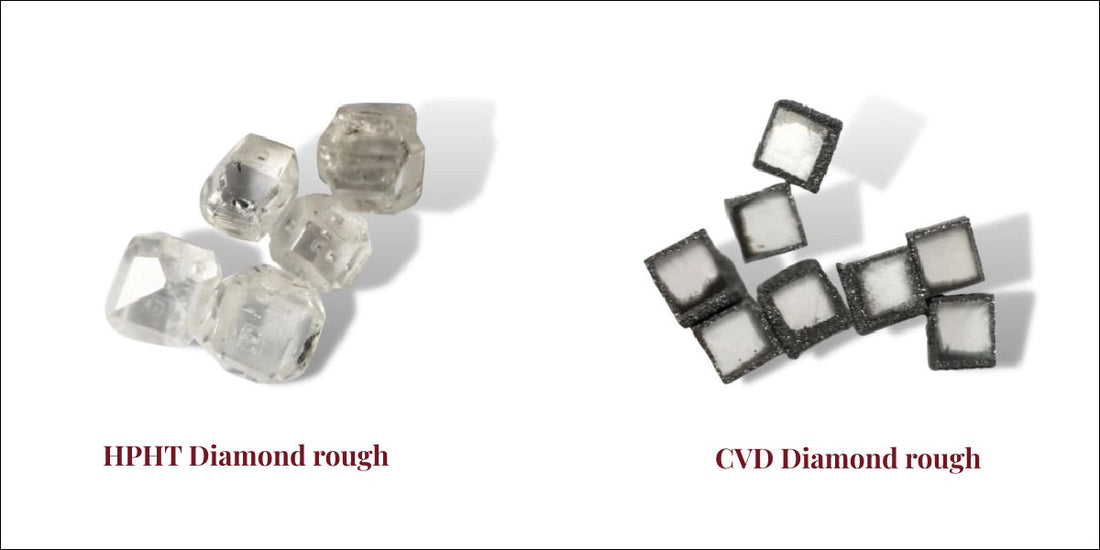
CVD vs HPHT
Share
HPHT vs. CVD Lab-Grown Diamonds: Understanding the Differences
Empowering Your Choice with Ever Jewels

What Are Lab-Grown Diamonds?
Lab-grown diamonds are real diamonds created in controlled environments using advanced technological processes. They possess the same physical, chemical, and optical properties as natural diamonds but are produced through two primary methods:
-
High Pressure High Temperature (HPHT)
-
Chemical Vapor Deposition (CVD)
Understanding the distinctions between these methods can help you choose the diamond that best suits your needs.
HPHT (High Pressure High Temperature)
Process Overview:
HPHT simulates the natural conditions under which diamonds form in the Earth's mantle. A small diamond seed is placed in carbon and subjected to extreme pressure (approximately 5-6 GPa) and high temperatures (around 1,500°C). This environment causes the carbon to melt and crystallise around the seed, forming a diamond.

 "Illustration of the HPHT diamond creation process."
"Illustration of the HPHT diamond creation process."
Characteristics:
-
Color: Often produces diamonds with a slight yellow or brown tint due to nitrogen impurities.
-
Clarity: May contain metallic inclusions from the metal catalysts used in the process.
-
Growth Pattern: Typically results in a cuboctahedral shape with 14 growth sectors.
-
Production Time: Generally faster, making it suitable for producing larger diamonds.
CVD (Chemical Vapor Deposition)
Process Overview:
CVD involves placing a diamond seed in a vacuum chamber filled with carbon-rich gases, such as methane. The gases are ionized using microwaves or lasers, breaking down the molecules so that carbon atoms deposit onto the seed, growing the diamond layer by layer.


"Illustration of the CVD diamond creation process."
Characteristics:
-
Color: Typically yields colorless or near-colorless diamonds, though some may have a brownish hue that can be treated post-growth.
-
Clarity: Generally higher clarity due to fewer inclusions.
-
Growth Pattern: Results in a cubic shape with uniform growth.
-
Production Time: Slower growth process, allowing for better control over the diamond's properties.
Comparative Overview
| Aspect | HPHT | CVD |
|---|---|---|
| Color | Slight yellow/brown tint | Colorless or near-colorless |
| Clarity | May have metallic inclusions | Higher clarity with fewer inclusions |
| Growth Pattern | Cuboctahedral shape | Cubic shape |
| Production Time | Faster | Slower, with more control over properties |
| Cost | Generally more affordable | Slightly higher due to controlled growth |
Making the Right Choice
HPHT Diamonds are ideal if you:
-
Seek a larger diamond at a more affordable price.
-
Prefer a diamond with a warmer hue.
CVD Diamonds are suitable if you:
-
Desire a colorless diamond with high clarity.
-
Value precision and uniformity in diamond structure.
Ever Jewels Commitment
At Ever Jewels, we offer a curated selection of both HPHT and CVD lab-grown diamonds, each certified and ethically sourced. Our experts are here to guide you through every step, ensuring you find a diamond that resonates with your story.
Services Offered:
-
Personalized consultations.
-
GIA/IGI certified diamonds.
-
Custom jewelry design.
Ready to explore your options?
Empower your choice with Ever Jewels—where knowledge meets elegance.

